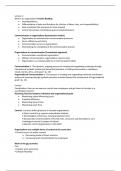Lecture 1:
What is an organization? Charles Redding
• Interdependence
• Differentiation of tasks and functions (ie, division of labor, roles, and responsibilities)
• Goal orientation (for everyone to strive toward)
• Control (to achieve coordinated, goal-oriented behaviour)
Communication in organizations (transmission model)
• Organization as containers for communication processes
• Focus: efficiency and clarity
• Communication occurs in organizations
• Overlooking the complexity of the communication process
Organizations as communication (Constitutive approach)
• Communication constitutes organization
• Without communication, organizations cease to exist
• Organizations as complex patterns of communication habits
Communication is “the dynamic, ongoing process of creating and negotiating meanings through
interactional symbolic (verbal and nonverbal) practices, including conversations, metaphors,
rituals, stories, dress, and space” (p. 14)
Organizational Communication is “the process of creating and negotiating collective coordinated
systems of meaning through symbolic practices oriented toward the achievement of organizational
goals” (p. 15)
Control
Coordination: How can we exercise control over employees and get them to function in a
coordinated manner?
Resolving Tensions between individual and organizational goals
• Maximizing salary Minimizing costs
• Creativity Efficiency
• Maximizing leisure time
• Maximizing work time
Control: a central, defining feature of complex organizations
• Direct control (e.g. superior-subordinate relation)
• Technological control (e.g. moving production line)
• Bureaucratic control (systems of formal rules, structures, job descriptions, etc.)
• Ideological control (a system of values)
• Biocratic control (organization is life itself)
Organizations use multiple forms of control at the same time
• Control occurs via active consent
Decreasing levels of direct coercion
Increasing levels of participation by employees
Work in the gig economy
Pros
• Greater work autonomy
• Lifestyle flexibility
,Cons
• Reduced work benefits (e.g. health care, pension plan)
• Combining multiple jobs
• Less work-life balance
Lecture 2: Fordism
A historical perspective
The emergence of the modern organization
The importance of scientific management in changing how work is managed and conducted
The role of bureaucracy in shaping the modern organization
The legacy of Fordism for the modern organization
“Before the late nineteenth century in the US, there were workers,
but the employee did not exist.” – Roy Jacques (1996, p.68)
• Transportation with natural and organic limitations
• Social norm: self-employed
• Wage slavery – term used in mid-1800s to describe working for someone else
The emergence of the modern organization
• Shift from agrarian to urban society
• Emergence of mechanical power
Allowed efficient movement of goods
Shift in human experience of time and space
• Shift to industrial society required new kind of worker
• shift from “task time” to “clock time”:
Task time = organic sense of time shaped by tasks
Clock time = time as form of currency; workers paid for time they work
The Fordist organization
• Highly bureaucratic structure
• Highly differentiated labour process
• Large economies of scale
• Standardization of products
Communication doesn’t enable but constraints in what the workers can and cannot communicate.
Communication is not seen as a key element in the Fordist organization.
Problems of the Fordist model
• Change of internal and external conditions
Markets become saturated
The labour force stopped accepting the discipline imposed by the Fordist environment.
(ex, a wildcat strike)
• Worker-dependent
• Lack of flexibility
Toyotism
• A new system of production
• Manufacturers had to learn how to be competitive in a zero-growth market environment.
Cost-cutting strategy
“just in time” philosophy; no stocks of components, no warehouses, no dead times
, System of Kaizen; kai=change zen=good; continuously change yourself to become better
Scientific management
• Fredrick Winslow Taylor
• First systematic effort to develop principles regarding management of workers. (for example,
guides for how to manage for a CEO so when a new CEO comes, they know what to do.)
• Taylor attempting to overcome system of “ordinary management,” which as based on “rules
of thumb” decision-making.
Principles of scientific management
1. Scientific Job Design: Each task is carefully analyzed and redesigned according to scientific
principles
2. Scientific selection and training of workers: Management matches each worker to
Eco division aka equal division
3. Cooperation Between Management & Workers: Managers ensure work corresponds to the
principles & provide supportive work environment
4. Equal Division of Work between Management and Workers: Management has responsibility
for designing tasks; workers execute them according to scientific design
The one-best way: widely accepted, taken-for-granted way of organizing work (ex: smiling
professionally in airlines for the airhostess which is a scientific management)
Criticisms of scientific management
Every worker is constrained physically and mentally and restricts creativity
Workers just work with their hands without having to think much to at all with the repetition
of activity
Operated with a limited conception of communication
o Communication as mechanical process
o Managers transmit information downward to employees
Separation of conception of work from its execution
Place all knowledge with managers; workers simply execute tasks
Hand and brain not just divided, but hostile to each other; worker is alienated from labor
process
Deskilling of work
Human body as focal point of control efforts
Bureaucratic theory
Max weber
Sociologist and philosopher
Interested in forms of power that had emerged in different societies
Made a distinction between power and authority:
Power: Ability to exercise one’s will, despite resistance by others
Authority (legitimate): A society’s development of a system of rules, norms, and administrative
apparatus to which people adhere
Three types of authority
1. Charismatic authority:
• “Gift of grace”
• Identification of an individual as possessing exceptional qualities that can move people
• Authority based in followers’ belief in validity and truth of their powers
• Tends to be characterized by instability and chaos; because
charisma is located in an individual, potential for disruption is high




